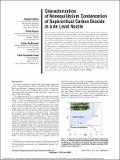| dc.contributor.author | Lettieri, Claudio | |
| dc.contributor.author | Bryanston-Cross, Peter | |
| dc.contributor.author | Paxson, Derek Edwin | |
| dc.contributor.author | Spakovszky, Zoltan S | |
| dc.date.accessioned | 2018-04-13T14:04:32Z | |
| dc.date.available | 2018-04-13T14:04:32Z | |
| dc.date.issued | 2017-11 | |
| dc.date.submitted | 2017-08 | |
| dc.identifier.issn | 0742-4795 | |
| dc.identifier.issn | 1528-8919 | |
| dc.identifier.uri | http://hdl.handle.net/1721.1/114689 | |
| dc.description.abstract | Carbon capture and storage could significantly reduce carbon dioxide (CO₂) emissions. One of the major limitations of this technology is the energy penalty for the compression of CO₂ to supercritical conditions. To reduce the power requirements, supercritical carbon dioxide compressors must operate near saturation where phase change effects are important. Nonequilibrium condensation can occur at the leading edge of the compressor, causing performance and stability issues. The characterization of the fluid at these conditions is vital to enable advanced compressor designs at enhanced efficiency levels but the analysis is challenging due to the lack of data on metastable fluid properties. In this paper, we assess the behavior and nucleation characteristics of high-pressure subcooled CO₂ during the expansion in a de Laval nozzle. The assessment is conducted with numerical calculations and corroborated by experimental measurements. The Wilson line is determined via optical measurements in the range of 41-82 bar. The state of the metastable fluid is characterized through pressure and density measurements, with the latter obtained in a first-of-its-kind laser interferometry setup. The inlet conditions of the nozzle are moved close to the critical point to allow for reduced margins to condensation. The analysis suggests that direct extrapolation using the Span and Wagner equation of state (S-W EOS) model yields results within 2% of the experimental data. The results are applied to define inlet conditions for a supercritical carbon dioxide compressor. Full-scale compressor experiments demonstrate that the reduced inlet temperature can decrease the shaft power input by 16%. | en_US |
| dc.publisher | American Society of Mechanical Engineers (ASME) | en_US |
| dc.relation.isversionof | http://dx.doi.org/10.1115/1.4038082 | en_US |
| dc.rights | Article is made available in accordance with the publisher's policy and may be subject to US copyright law. Please refer to the publisher's site for terms of use. | en_US |
| dc.source | ASME | en_US |
| dc.title | Characterization of Nonequilibrium Condensation of Supercritical Carbon Dioxide in a de Laval Nozzle | en_US |
| dc.type | Article | en_US |
| dc.identifier.citation | Lettieri, Claudio et al. “Characterization of Nonequilibrium Condensation of Supercritical Carbon Dioxide in a de Laval Nozzle.” Journal of Engineering for Gas Turbines and Power 140, 4 (November 2017): 041701 © 2018 ASME | en_US |
| dc.contributor.department | Massachusetts Institute of Technology. Department of Aeronautics and Astronautics | en_US |
| dc.contributor.mitauthor | Paxson, Derek Edwin | |
| dc.contributor.mitauthor | Spakovszky, Zoltan S | |
| dc.relation.journal | Journal of Engineering for Gas Turbines and Power | en_US |
| dc.eprint.version | Final published version | en_US |
| dc.type.uri | http://purl.org/eprint/type/JournalArticle | en_US |
| eprint.status | http://purl.org/eprint/status/PeerReviewed | en_US |
| dc.date.updated | 2018-04-11T12:51:29Z | |
| dspace.orderedauthors | Lettieri, Claudio; Paxson, Derek; Spakovszky, Zoltan; Bryanston-Cross, Peter | en_US |
| dspace.embargo.terms | N | en_US |
| dc.identifier.orcid | https://orcid.org/0000-0002-0673-430X | |
| dc.identifier.orcid | https://orcid.org/0000-0003-2167-9860 | |
| mit.license | PUBLISHER_POLICY | en_US |
